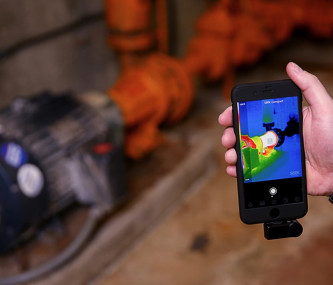Infrared Vision: a Snake’s Eye for Fixing Short Circuits?
May 02, 2019
on
on
 A bit of detail before passing on to more serious matters: it’s not really correct to speak of its eye which gives a snake thermal vision, but its skin. More exactly, there are thermally sensitive facial pits, also present, depending on the species, on different parts of the body. A layer of cells with a large number of thermoreceptors connected to the brain. The snake thus senses the slightest variation in temperature. This permits it to locate its prey, and even evaluate its distance.
A bit of detail before passing on to more serious matters: it’s not really correct to speak of its eye which gives a snake thermal vision, but its skin. More exactly, there are thermally sensitive facial pits, also present, depending on the species, on different parts of the body. A layer of cells with a large number of thermoreceptors connected to the brain. The snake thus senses the slightest variation in temperature. This permits it to locate its prey, and even evaluate its distance.
YouTube or “On the art of wasting time more or less usefully"
 The popularity of infrared vision devices has literally exploded in the past few years. As the Elektor Store offers various models in its range, amongst which are the famous SEEK accessories which connect to a smartphone, I found an interesting subject for this article. Without preconceptions, I searched for convincing videos which neither merely unpack the product nor stumble through what anyone can read elsewhere. This research had a price: I wasted some of my time to reduce the risk of you wasting yours!
The popularity of infrared vision devices has literally exploded in the past few years. As the Elektor Store offers various models in its range, amongst which are the famous SEEK accessories which connect to a smartphone, I found an interesting subject for this article. Without preconceptions, I searched for convincing videos which neither merely unpack the product nor stumble through what anyone can read elsewhere. This research had a price: I wasted some of my time to reduce the risk of you wasting yours!Patience, we’re getting there…
Night vision and infrared thermography
Used for night vision and thermography, infrared radiation permits viewing and measuring the temperature of various targets, remotely and without contact. At first, my researches were not constrained to electronics as a field of application of IR vision. I hoped to find something less … commonplace.After wandering among hunters and plumbers, among deer and suspect piping, just as I was about to give up, I realised that it was still electronics that offered the best subjects and went into fine details. I (re)found a video which posed the question: is an infrared camera a useful tool for detecting electronic faults? The first time I found it, I passed over this video without looking at it, because its title seemed so obscure: Seek Compact Pro Thermal cam versus My Face for iPhone short circuit detection. What the heck was My Face doing in there? But I almost missed a pearl.
The clip I offer is found at the beginning of a practical faultfinding session of over an hour, initially posted live on YouTube (thus without editing). It’s on the channel of Jessa Jones, of whom you may know. She has earned an enviable reputation for the faultfinding and repair of mobile devices. If you’re interested in the equipment needed for micro-soldering, these videos are (long but) instructive.
This one is doubly so. It shows, in ten minutes or so, that Infrared vision accessories mounted on a smartphone are useful to the electronicist. It also suggests the use of a thermal sensor that everyone has, like snakes: skin!
”Macro” lens
I didn’t have the time to view the rest of this faultfinding sequence, where it’s all a question of using the IR camera for the faultfinding. It’s up to you to decide if you have the time to devote to it.During my search, I came across this other video, from another author. It illustrates the benefits of adding a macro lens to the Seek infrared module. Apparently, this considerably improves the clarity of the images obtained. In electronics, such clarity is not a luxury.
One cannot just use any old lens, obviously, because it has to pass infrared rays. You can find more information on this subject in other videos.
Read full article
Hide full article


Discussion (0 comments)